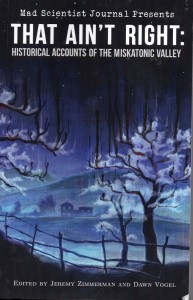Book Review: That Ain’t Right edited by Jeremy Zimmerman & Dawn Vogel
Disclaimer: I received this book in a Goodreads giveaway on the premise that I would review it.
Howard Phillips “H.P.” Lovecraft (1890-1937) was a minor writer of horror fiction in the early 20th Century. But thanks to a gift for purple prose, a strong philosophical unity in his stories’ viewpoints and (most importantly) a willingness to share his ideas, he’s been immensely influential in the development of the horror field. He’s best known for the Cthulhu Mythos, a series of stories involving cosmic “gods” that are implacably hostile to humanity as we know it, not out of malice as such, but because humans are irrelevant to the universe at large.
A number of his stories were set in the Miskatonic Valley region of Massachusetts, a fictional backwater including such shadowed locations as Innsmouth, Dunwich and Arkham. That last one will be familiar to Batman fans.
Which brings us to the book at hand, an anthology of first-person narratives set in the Miskatonic Valley. They range in time period from about the 1890s to the far future, and one is set in an alternate history. As is traditional in Lovecraft-inspired fiction, several of the narrators cannot be telling their stories to any living person, although none of them are quite to the level of that one Lovecraft protagonist who was still writing in his journal even as the monster was actually entering the room. An especially nice touch is that the fictional narrators have their own author bios at the end of the stories.
Some standouts in the anthology include:
- “Arkquarium” by Folly Blaine: A high school student working part-time at the Arkham Aquarium tries to impress the girl he likes by sneaking into the locked laboratory section. Turns out there’s a reason no one is supposed to go in there. The protagonist shows some gumption, but isn’t unrealistically competent beyond the average teenager he is.
- “The Reservoir” by Brian Hamilton: A direct sequel to Lovecraft’s classic “The Colour Out of Space” which has a microbiologist investigating particles in the water of the title lake. He finds an old well still calling–or is it a hallucination of the deep?
- “The Pull of the Sea” by Sean Frost: A ghost learns that not even death can protect you from the worse horrors that come from the ocean. The story carefully sets up rules, then the creatures that break the rules come along.
- “The Laughing Book” by Cliff Winnig: A college student studies the title book in the restricted stacks of Miskatonic University. This story is more influenced by Lovecraft’s “Lord Dunsany” period of dark fantasy than his straight-up horror.
The quality of writing is generally good, absent a couple of typos, and the annoying use of phonetic dialect in “Dr. Circe and the Shadow Over Swedish Innsmouth” by Erik Scott de Bie. Horror tends to be subjective as to whether it works for you or not; I found most of the stories nicely creepy, with a couple going a bit too much for the gore for my tastes.
Recommended for fans of the Cthulhu Mythos, and the more literate horror fan in general.

